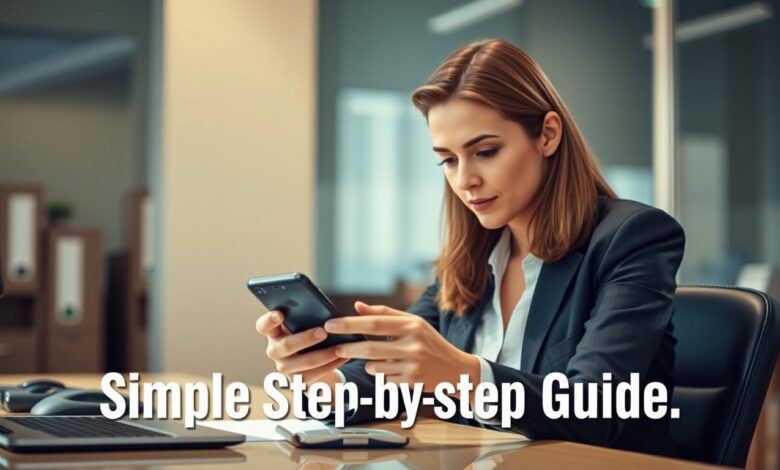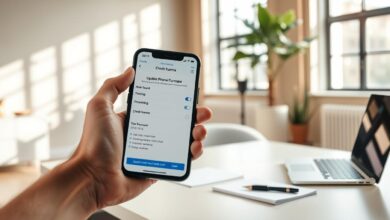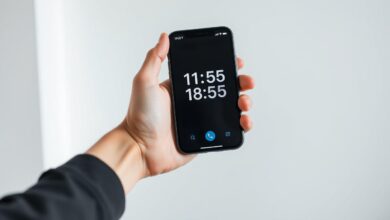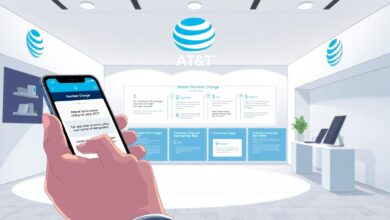Changing My Phone Number: A Simple Step-by-Step Guide

Changing your phone number is easy if you know the right steps. This phone number change guide will show you how. It makes updating your phone number simple and stress-free.
Whether you’re changing carriers or just updating your number, knowing the change phone number process is key. This guide will help you do it quickly and easily.
Key Takeaways
- Understand the steps involved in changing your phone number.
- Learn how to update your phone number with your carrier.
- Discover the importance of updating your phone number on other services.
- Find out how to avoid disruptions during the change process.
- Get tips on maintaining your new phone number securely.
Why I Decided to Change My Phone Number
Changing my phone number was a choice I made after careful thought. I faced many challenges with my old number. It was clear that a change was needed.
Personal Security and Privacy Concerns
I changed my number for personal security and privacy. With digital threats on the rise, I felt my old number was at risk. I wanted to protect myself from identity theft and harassment.
Dealing with Spam and Harassment
I also dealt with a lot of spam and harassment on my old number. Even with blocking, the problem didn’t go away. Changing my number helped me control my communication and cut down on unwanted calls.
Relocating to a New Geographic Area
Lastly, I moved to a new geographic area. Getting a local number was practical. It made talking to locals easier and saved me money on calls.
These reasons led me to change my phone number. It has greatly improved my life and security.
Understanding the Implications of Changing Your Number
Changing your phone number is more than just updating a contact detail. It can change your digital identity. This change can affect different parts of your life.
Impact on Two-Factor Authentication Systems
Changing your number can affect two-factor authentication (2FA) systems. Many online services, like banking and social media, use your phone number for security. If you don’t update these services, you might face authentication problems. This could lock you out of your accounts.
It’s important to update your 2FA settings on all platforms before changing your number.
Potential for Missed Important Communications
Changing your number might mean missing important calls or texts. This could include calls from unknown numbers or SMS codes. To avoid this, set up call forwarding or auto-responders to let senders know your new number.
Professional and Business Considerations
Changing your phone number can impact your work and client relationships. It’s important to tell your contacts and update your number on professional sites and marketing materials.
Digital Identity Management Challenges
The table below summarizes key considerations when managing digital identity after a phone number change:
| Aspect | Action Required | Potential Impact |
|---|---|---|
| Two-Factor Authentication | Update phone number on all 2FA-enabled services | Authentication issues if not updated |
| Professional Contacts | Notify clients and update professional profiles | Missed business opportunities if not updated |
| Digital Services | Update phone number on banking, social media, etc. | Account access issues if not updated |
Understanding these implications helps you prepare for a smooth transition when changing your phone number.
Preparing for the Phone Number Change
When I was about to change my phone number, I knew I had to take some important steps. This would help me make the switch smoothly.
Creating a Comprehensive Contact List
I started by making a detailed contact list. I listed everyone I talk to often, like family, friends, and work colleagues. I also included banks, service providers, and other important contacts. This list showed me how many places I needed to update my number.
Identifying Services Linked to Your Current Number
Next, I found out which services used my old phone number. This included banks, social media, email, and online subscriptions. I made a list of each one so I could update them later.
Backing Up Text Messages and Call Logs
Backing up my texts and calls was key. I used my phone’s backup feature to save everything to the cloud. This way, I wouldn’t lose any important messages when I got a new number. I also saved the backup on my computer for extra safety.
Setting Up Temporary Communication Alternatives
To avoid any trouble during the change, I set up temporary ways to stay in touch. I told important people about my new number and gave it to them early if I could. I also thought about using call forwarding to my new number to catch any missed calls.
By doing these things, I was ready for the phone number change. I was able to handle the transition without any big problems.
How to Change a Phone Number with Major US Carriers
Big US carriers like AT&T, Verizon, and T-Mobile make it easy to change your phone number. You can do it online, through a mobile app, or by visiting a store.
AT&T Number Change Process
AT&T lets you change your number in two ways: online or in-store.
Online Method
To change your number online with AT&T, follow these steps:
- Log in to your AT&T account on their official website.
- Navigate to the “My Profile” or “Account Settings” section.
- Look for the “Change Phone Number” or similar option.
- Follow the prompts to select a new number or change your existing one.
In-Store Method
You can also change your number at an AT&T store. Just remember to bring a valid ID.
Verizon Number Change Process
Verizon offers several ways to change your number. You can use their mobile app or contact customer service.
Through My Verizon App
Changing your number with the My Verizon app is easy:
- Download and install the My Verizon app if you haven’t already.
- Log in to your Verizon account.
- Navigate to the “Settings” or “Account” section.
- Select the option to change your phone number.
Customer Service Options
If you’d rather talk to someone, Verizon’s customer service can help you change your number over the phone.
T-Mobile Number Change Process
T-Mobile makes it simple to change your number. You can use their self-service portal or visit a store.
Self-Service Portal Steps
To change your number on T-Mobile’s self-service portal:
- Log in to your T-Mobile account on their website.
- Go to the “Account Settings” or “Profile” section.
- Find the option to change your phone number.
- Follow the instructions to complete the change.
T-Mobile Store Assistance
For in-person help, visit a T-Mobile store to change your number.
For more details on changing your phone number and other services, check out https://dialaxy.com/blogs/11-best-apps-to-change-phone-number/.
| Carrier | Online Method | In-Store Method | Customer Service |
|---|---|---|---|
| AT&T | Yes | Yes | Yes |
| Verizon | Yes (through My Verizon App) | Yes | Yes |
| T-Mobile | Yes (through Self-Service Portal) | Yes | Yes |
Changing My Phone Number Online: My Experience
Changing my phone number online was easy and quick. My carrier’s website made it simple. I did it all from home, without going to a store or waiting on the phone.
Creating and Accessing My Carrier Account
I first logged into my carrier account on their website. If you’re new, setting up an account is easy. You just need your name, email, and current phone number. Once in, I could change my phone number easily.
Navigating to Number Change Options
Finding the number change option was easy. The website gave clear steps. I could pick a new number or port one from another carrier.
Verification Steps I Encountered
Security is key when changing your account. So, I had to verify my identity. I got a code via email or SMS, which I entered on the website.
Confirmation and Activation Timeline
After finishing, I got a confirmation message. My new number was active in minutes. But, some carriers might take a few hours or up to 24 hours.
Visiting a Carrier Store: What to Expect
Changing my phone number at a carrier store was quicker than I thought. When I entered the store, a representative helped me right away.
Required Identification Documents
I had to show valid ID, like my driver’s license and proof of address. This is to make sure only I can change my account.
The In-Person Process I Experienced
The process was easy. The rep used my ID to start the number change. The whole thing took about 20 minutes. They explained everything and when it would be done.

Questions I Asked the Representative
I asked about any costs for changing my number. They told me about deals and how it would affect my services.
In-Store vs. Online: Pros and Cons
The in-store visit was quick, but it wasn’t as easy as online or phone. Yet, the personal help was a big plus. As one rep said,
“In-store visits provide an opportunity for customers to get detailed information and immediate support.”
Customer Service Call Method: Step by Step
To change my phone number, I called customer service. It was quick and easy. I got help right away and had my questions answered.
Preparing Information Before Calling
Before I called, I gathered all my info. I had my account details, current phone number, and more. This made the call go smoothly.
Navigating Automated Systems Efficiently
When I called, an automated system helped me. I listened to the options and chose the right one. This got me to a live person quickly.
What to Say to the Representative
When I talked to a rep, I told them I wanted to change my number. I gave them the info they needed. I also asked about any fees or changes.
Verification and Confirmation Procedures
The rep checked my identity and made the change. They told me when my new number would start working.
| Step | Description |
|---|---|
| 1 | Prepare necessary information |
| 2 | Navigate automated system |
| 3 | Speak to a representative |
| 4 | Verification and confirmation |
Costs and Fees I Encountered
Changing my phone number showed me the different fees involved. Knowing these costs helped me make a smart choice.
Standard Carrier Fees Breakdown
Carriers usually charge a fee for changing your number. For example, AT&T and Verizon might ask for $10-$15. Always check with your carrier for their exact fees.
Hidden Costs to Watch For
There are also hidden costs. These can include fees for moving services or features tied to your old number. I found out there was a fee for moving my number to a new SIM card.
Money-Saving Strategies I Used
To save money, I looked at fees from different carriers and picked the best one. Some carriers might offer deals or waive fees under certain conditions. It’s good to ask about these.
Comparing Costs Across Carriers
I looked into the costs of changing my number across major US carriers. Here’s what I found:
- AT&T: $12.95 for number change
- Verizon: $10 for number change, with extra fees for some services
- T-Mobile: Free number change with certain plans
Selecting My New Phone Number
Changing my phone number was more than just picking a random number. I had to think carefully to make sure it was right for me and easy for others to reach me.
Area Code Selection Considerations
Choosing an area code was my first step. I thought about picking one that my friends and family knew or matched where I live. Choosing an area code that fits my location or work network makes talking easier. For example, a number tied to my business area helps clients remember it.
Choosing Between Vanity and Random Numbers
I had to choose between a vanity number or a random one. Vanity numbers are easy to remember and can spell out words or phrases. Vanity numbers are great for businesses to boost their brand. But, random numbers are cheaper and easier to get.
Number Portability Rules and Limitations
It was important to understand the rules of number portability. Not all numbers can be moved, and some carriers have rules. Knowing these helped me plan better.
Checking Number History Before Selecting
Before picking my new number, I checked its past. I wanted to make sure it wasn’t linked to bad activities. This made me feel secure and helped avoid unwanted calls or messages.
Virtual Number Alternatives I Considered
I looked for a more flexible phone solution and found virtual number alternatives. Changing my phone number showed me virtual numbers have many benefits. They are different from traditional phone numbers.
Google Voice Options
Google Voice was a top choice for me. It gives a free phone number for calls, texts, and voicemails. It’s great for keeping your personal number private or for online use. Google Voice works well with other Google services, making it easy for Google users.
Burner Apps and Temporary Numbers
Burner apps and temporary numbers were also on my list. They offer a short-term phone number for privacy and less spam. Burner apps are perfect for online deals or unknown contacts.
VoIP Services as Alternatives
VoIP services were another option I checked out. They let you call using the internet, not a traditional phone line. VoIP services save money and are flexible, especially for those who make lots of calls.
Comparing Traditional vs. Virtual Number Benefits
Virtual numbers have clear advantages over traditional ones. They are more flexible and private. You can use them on many devices and get extra privacy features.
“Virtual numbers are changing how we talk, offering more flexibility and privacy than traditional numbers.”
In summary, options like Google Voice, burner apps, and VoIP services have many benefits. They offer privacy and flexibility. When I thought about changing my phone number, these alternatives were key to finding the right choice for me.
Updating My Critical Accounts After the Change
After changing my phone number, I had to update my important accounts. This ensured I could keep using them without any issues. I checked all accounts linked to my old number.
Banking and Financial Services Updates
I started by updating my banking and financial services. I told my bank, credit card companies, and other financial places about the change. I used their apps and websites to update my phone number in the account settings.
For example, I had to call my bank to confirm my identity before changing my number. Some places needed me to visit in person, while others let me do it online.
Social Media and Email Account Security
Then, I updated my social media and email accounts. I went to each platform’s settings to change my phone number. This was key for keeping my accounts safe and easy to recover if needed.
I also turned on two-factor authentication (2FA) where I could. This added more security. For email, updating my number helped me get verification codes and security alerts.
Subscription and Delivery Services
I also updated my subscription services. This included streaming, software, and delivery services. I did this so I could keep getting services without any problems.
Government, Healthcare, and Insurance Accounts
Updating my government, healthcare, and insurance accounts was very important. I contacted government agencies, healthcare providers, and insurance companies to update my records. This included my driver’s license, medical records, and insurance policies.
Professional Networking Platforms
Lastly, I updated my professional networking profiles. I changed my phone number on LinkedIn and other networks. This made sure my colleagues and contacts could reach me.
| Category | Actions Taken | Notes |
|---|---|---|
| Banking and Finance | Updated phone number with bank, credit card companies | Some required in-person visits |
| Social Media and Email | Updated phone number, enabled 2FA | Enhanced security measures |
| Subscriptions and Deliveries | Updated phone number on streaming, software, and delivery services | Ensured continuous service |
| Government, Healthcare, and Insurance | Updated records with government agencies, healthcare providers, and insurers | Critical for official records and services |
| Professional Networking | Updated phone number on professional networks like LinkedIn | Ensured colleagues could contact me |
Notifying My Contacts Effectively
Notifying my contacts about my new phone number needed a smart plan. I made a plan that fit different groups of contacts.
Developing a Tiered Contact Strategy
I sorted my contacts into tiers based on how important they were and how often I talked to them. This tiered contact strategy helped me focus on who to notify first and how to message them.
Family and close friends were in the first tier. I reached out to them personally. The second tier had acquaintances and contacts I didn’t talk to as often. I sent them group messages or updates on social media.
Using Group Messages and Social Media
For the second tier, I used group messages and social media to share my new number. This way, I could quickly tell many people at once.
I made a simple message with my new number and a quick reason for the change. Using these platforms saved me time and effort.

Professional Contact Notification Templates
For work contacts, I made a template that was both professional and polite. I used it in emails and formal messages to keep things clear and consistent.
Following Up with Important Contacts
After I first told them, I checked in with key contacts to make sure they had my new number. This was important to make sure my important contacts had the right info.
| Contact Tier | Notification Method | Follow-Up |
|---|---|---|
| Tier 1: Close Contacts | Personal Calls/Messages | Direct Follow-Up |
| Tier 2: Acquaintances | Group Messages/Social Media | No Follow-Up |
| Tier 3: Professional Contacts | Email/Professional Messaging | Selective Follow-Up |
Managing the Transition Period Successfully
To avoid disruptions, I focused on managing the transition after changing my number. I took several steps to make sure I didn’t miss any important messages during the switch.
Setting Up Call Forwarding Options
I began by setting up call forwarding from my old to my new number. This made sure I didn’t miss any important calls during the transition. Most carriers let you set this up online or by calling customer service.
Creating Automated Responses for Texts
To handle texts, I set up automated responses to let senders know I had changed my number. This was great for updating contact information. I used a simple message that included my new number.
Handling Missed Communications
Even with these steps, there was still a chance of missing some messages. I regularly checked my old number for any missed calls or texts. I followed up as needed to keep things running smoothly.
Timeline for Complete Transition
The transition took a few weeks, and I watched it closely. I tracked any issues and fixed them quickly. This way, I ensured a smooth transition to my new phone number.
Privacy and Security Benefits I Gained
Changing my phone number was more than just a simple update. It brought many privacy and security benefits. One big advantage was fewer unwanted calls, like spam and robocalls that used to flood my old number.
Reducing Digital Footprint
By changing my phone number, I reduced my digital footprint. Many online services and data brokers had my old number. Switching to a new one limited how much they could share my personal info. This helped lower the risk of my data being used or sold without my okay.
Escaping Spam and Robocalls
I got a lot fewer spam and robocalls after changing my number. My old number was a magnet for unwanted calls. But my new number started fresh, without these problems.
Enhanced Personal Security Measures
The change also made me safer. With a new number, I could control who got my contact info. This reduced the chance of harassment or stalking. It was key for keeping me safe and secure.
Data Privacy Improvements
Updating my phone number also boosted my data privacy. I could check and update my identity info. This made my data safer and less likely to be hacked.
In conclusion, changing my phone number brought big privacy and security wins. It cut down on unwanted calls and made me safer and more private. These gains have been huge in keeping my identity safe and my mind at ease.
Troubleshooting Problems I Encountered
Changing my phone number was not without its hurdles. Despite the challenges, I found ways to overcome them. A few unexpected issues popped up along the way.
Two-Factor Authentication Recovery
One big problem was two-factor authentication (2FA) recovery. Many accounts used my old number for 2FA. So, I had to regain access to them. I had to verify my identity through email or security questions for each service.
For example, I visited the Verizon support page to learn how to update my 2FA info.
Dealing with Service Interruptions
During the change, I faced some service interruptions. These were short-lived and fixed once the number change was complete. To avoid any issues, I set up call forwarding to my new number temporarily.
Resolving Carrier-Specific Issues
Carrier-specific problems also came up. For instance, I had to call my carrier’s customer service for a billing issue. Being ready with my account details and a clear problem description helped solve it quickly.
Account Access Challenges
Getting into some accounts was tough. I had to reset passwords and update my number on different platforms. Using a password manager made this easier by keeping my login info current.

In summary, changing my phone number had its challenges. But being prepared and knowing where to get help made it more doable.
Conclusion: Reflecting on My Phone Number Change Journey
Changing my phone number was a big step that needed a lot of thought. Looking back, I found important lessons for anyone thinking of making the same change.
I learned how to get ready for the change. This included updating important accounts, telling friends and family, and handling the time it takes to adjust. I faced some tough spots, like fixing two-factor authentication and dealing with carrier problems.
Despite the challenges, the whole experience wasn’t as scary as I thought. By knowing what to expect and how to solve problems, I made it through without a hitch.
Switching my number has brought many good things. It’s made me feel safer and cut down on unwanted calls. It’s been a good choice.
FAQ
How long does it take to change my phone number with my carrier?
Changing your phone number’s time frame varies by carrier and method. Online changes happen fast. In-store or customer service changes might take a few minutes to hours.
Will changing my phone number affect my existing phone plan or services?
Usually, changing your number won’t affect your plan or services. But, it’s best to check with your carrier to make sure.
Can I port my existing phone number to a new carrier?
Yes, you can usually port your number to a new carrier. You’ll need to give your current carrier info and follow the new carrier’s steps. This can take a few hours to days.
Are there any fees associated with changing my phone number?
Some carriers charge for changing your number. Fees can be to or more. Always check with your carrier about their fees.
How do I update my phone number with services like Netflix or banking institutions?
To update your number with services like Netflix, log in and change your number in settings. You might also need to call their customer service.
Can I use a virtual phone number as an alternative to changing my actual phone number?
Yes, you can use virtual numbers like Google Voice as an alternative. They let you get calls and texts without changing your main number.
What should I do if I encounter issues with two-factor authentication after changing my phone number?
If two-factor authentication problems arise, contact the service provider’s support. They can help you fix your account or update your number.
How can I minimize disruptions during the phone number change process?
To avoid disruptions, set up call forwarding and tell important contacts about the change. Also, update your number with key services and accounts before switching.
Are there any benefits to changing my phone number in terms of privacy and security?
Yes, changing your number can cut down on spam and unwanted calls. It’s good for privacy and security, especially if you’ve faced harassment or stalking.
Can I revert to my old phone number if I change my mind?
Usually, you can’t go back to your old number after changing it. But, you can talk to your carrier about options. They might let you port your new number back, depending on their rules.



